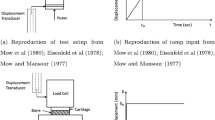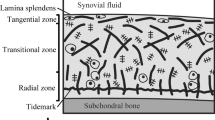Abstract
Cartilaginous tissues, such as articular cartilage and the annulus fibrosus, exhibit orthotropic behavior with highly asymmetric tensile–compressive responses. Due to this complex behavior, it is difficult to develop accurate stress constitutive equations that are valid for finite deformations. Therefore, we have developed a bimodular theory for finite deformations of elastic materials that allows the mechanical properties of the tissue to differ in tension and compression. In this paper, we derive an orthotropic stress constitutive equation that is second-order in terms of the Biot strain tensor as an alternative to traditional exponential type equations. Several reduced forms of the bimodular second-order equation, with six to nine parameters, and a bimodular exponential equation, with seven parameters, were fit to an experimental dataset that captures the highly asymmetric and orthotropic mechanical response of cartilage. The results suggest that the bimodular second-order models may be appealing for some applications with cartilaginous tissues.
Similar content being viewed by others
References
Akizuki S, Mow VC, Muller F, Pita JC, Howell DS, Manicourt DH (1986) Tensile properties of human knee joint cartilage: I. Influence of ionic conditions, weight bearing, and fibrillation on the tensile modulus. J Orthop Res 4:379–392
Almeida ES, Spilker RL (1997) Mixed and penalty finite element models for the nonlinear behavior of biphasic soft tissues in finite deformation. Part i-alternative formulations. Comput Methods Biomech Biomed Eng 1:25–46
Ateshian GA, Warden WH, Kim JJ, Grelsamer RP, Mow VC (1997) Finite deformation biphasic material properties of bovine articular cartilage from confined compression experiments. J Biomech 30:1157–1164
Baer AE, Laursen TA, Guilak F, Setton LA (2004) The micromechanical environment of intervertebral disc cells determined by a finite deformation, anisotropic, and biphasic finite element model. J Biomech Eng 125:1–11
Bank RA, Krikken M, Beekman B, Stoop R, Maroudas A, Lafeber FPJG, Te Koppele JM (1997) A simplified measurement of degraded collagen in tissues: Application in healthy, fibrillated and osteoarthritic cartilage. Matrix Biol 16:233–243
Basser PJ, Schneiderman R, Bank RA, Wachtel E, Maroudas A (1998) Mechanical properties of the collagen network in human articular cartilage as measured by osmotic stress technique. Arch Biochem Biophys 351:207–219
Bingham M, Davol A, Sah RL, Klisch SM (2005) A nonlinear finite element model of cartilage growth under in vitro dynamic compression. ASME summer bioengineering conference
Chahine NO, Wang CC, Hung CT, Ateshian GA (2004) Anisotropic strain-dependent material properties of bovine articular cartilage in the transitional range from tension to compression. J Biomech 37:1251–1261
Curnier A, He QC, Zysset P (1995) Conewise linear elastic materials. J Elast 37:1–38
Donzelli PS, Spilker RL, Ateshian GA, Mow VC (1999) Contact analysis of biphasic transversely isotropic cartilage layers and correlations with tissue failure. J Biomech 32:1037–1047
Eberlein R, Holzapfel GA, Schulze-Bauer CA (2001) An anisotropic constitutive model for annulus tissue and enhanced finite element analyses of intact lumbar disc bodies. Comp Meth Biomech Biomed Eng 4:209–230
Eckstein F, Lemberger B, Stammberger T, Englmeier KH, Reiser M (2000) Patellar cartilage deformation in vivo after static versus dynamic loading. J Biomech 33:819–825
Guilak F, Mow VC (2000) The mechanical environment of the chondrocyte:A biphasic finite element model of cell-matrix interactions in articular cartilage. J Biomech 33:1663–1673
Gurtin M (1984) Introduction to continuum mechanics. Academic Press, New York
Herberhold C, Faber S, Stammberger T, Steinlechner M, Putz R, Englmeier KH, Reiser M, Eckstein F (1999) In situ measurement of articular cartilage deformation in intact femoropatellar joints under static loading. J Biomech 32:1287–1295
Hoger A (1999) A second order constitutive theory for hyperelastic materials. Int J Solids Struct 36:847–868
Holmes MH, Mow VC (1990) The nonlinear characteristics of soft gels and hydrated connective tissue in ultrafiltration. J Biomech 23:1145–1156
Holzapfel GA, Gasser TC, Ogden RW (2004) Comparison of a multi-layer structural model for arterial walls with a fung-type model, and issues of material stability. J Biomech Eng 126:264–275
Huang CY, Stankiewicz A, Ateshian GA, Flatow EL, Bigliani LU, Mow VC (1999) Anisotropy, inhomogeneity, and tension-compression nonlinearity of human glenohumeral cartilage in finite deformation. Trans Orthop Res Soc (in press)
Huang CY, Stankiewicz A, Ateshian GA, Mow VC (2005) Anisotropy, inhomogeneity, and tension-compression nonlinearity of human glenohumeral cartilage in finite deformation. J Biomech 38:799–809
Klisch SM, Hoger A (2003) Volumetric growth of thermoelastic materials and mixtures. Math Mech Solids 8:377–402
Klisch SM, Lotz JC (1999) Application of a fiber-reinforced continuum theory to multiple deformations of the annulus fibrosus. J Biomech 32:1027–1036
Klisch SM, Sah RL, Hoger A (2000) A growth mixture theory for cartilage. In: Casey J, Bao G (ed) Mechanics in biology. AMB 242 and BED 46, ASME
Klisch SM, Van Dyke T, Hoger A (2001) A theory of volumetric growth for compressible elastic materials. Math Mech Solids 6:551–575
Klisch SM, Chen SS, Sah RL, Hoger A (2003) A growth mixture theory for cartilage with applications to growth-related experiments on cartilage explants. J Biomech Eng 125:169–179
Klisch SM, Holtrichter SE, Sah RL, Davol A (2004) A bimodular second-order orthotropic stress constitutive equation for cartilage. Proceedings of IMECE (ASME)
Klisch SM, Sah RL, Hoger A (2005) A cartilage growth mixture model for infinitesimal strains: Solutions of boundary-value problems related to in vitro growth experiments. Biomech Model Mechanobiol 3:209–223
Korhonen RK, Laasanen MS, Toyras J, Lappalainen R, Helminen HJ, Jurvelin JS (2003) Fibril reinforced poroelastic model predicts specifically mechanical behavior of normal, proteoglycan depleted and collagen degraded articular cartilage. J Biomech 36:1373–1379
Krishnan R, Park S, Eckstein F, Ateshian GA (2003) Inhomogeneous cartilage properties enhance superficial insterstitial fluid support and frictional properties, but do not provide a homogeneous state of stress. J Biomech Eng 125:569–577
Kwan MK, Lai WM, Mow VC (1990) A finite deformation theory for cartilage and other soft hydrated connective tissues – i. Equilibrium results. J Biomech 23:145–155
Laasanen M, Toyras J, Korhonen R, Rieppo J, Saarakkala S, Nieminen M, Hirvonen J, Jurvelin JS (2003) Biomechanical properties of knee articular cartilage. Biorheology 40:133–140
Lai WM, Hou JS, Mow VC (1991) A triphasic theory for the swelling and deformation behaviors of articular cartilage. J Biomech Eng 113:245–258
Li LP, Herzog W (2004) Strain-rate dependence of cartilage stiffness in unconfined compression: The role of fibril reinforcement versus tissue volume change in fluid pressurization. J Biomech 37:375–382
Li L, Soulhat J, Buschmann MD, Shirazi-Adl A (1999) Nonlinear analysis of cartilage in unconfined ramp compression using a fibril reinforced poroelastic model. Clin Biomechanics 14:673–682
Maroudas A (1976) Balance between swelling pressure and collagen tension in normal and degenerate cartilage. Nature 260:808–809
Mow VC, Ratcliffe A (1997) Structure and function of articular cartilage and meniscus. In: Mow VC, Hayes WC (eds) Basic orthopaedic biomechanics. Raven Press, New York
Murnaghan FD (1937) Finite deformation of an elastic solid. Amer J Math 59:235–260
Murnaghan FD (1951) Finite deformation of an elastic solid. Dover, New York
Ogden RW (1984) Non-linear elastic deformations. Dover, Mineola, New York
Rivlin RS (1953) The solution of problems in second order elasticity theory. J Ration Mech Anal 2:53–81
Schinagl RM, Gurskis D, Chen AC, Sah RL (1997) Depth-dependent confined compression modulus of full-thickness bovine articular cartilage. J Orthop Res 15:499–506
Schroder J, Neff P, Balzani D (2005) A variational approach for materially stable anisotropic hyperelasticity. Int J Solids Struct 42:4352–4371
Soltz MA, Ateshian GA (2000) A conewise linear elasticity mixture model for the analysis of tension–compression nonlinearity in articular cartilage. J Biomech Eng 122:576–586
Soulhat J, Buschmann MD, Shirazi-Adl A (1999) A fibril-network-reinforced biphasic model of cartilage in unconfined compression. J Biomech Eng 121:340–347
Van Dyke TJ, Hoger A (2000) A comparison of second-order constitutive theories for hyperelastic materials. Int J Solids Struct 37:5873–5917
Venn MF, Maroudas A (1977) Chemical composition and swelling of normal and osteoarthritic femoral head cartilage. I. Chemical composition. Ann Rheum Dis 36:121–129
Wagner DR (2002) A mechanistic strain energy function and experimental results for the human annulus fibrosus. U.C. Berkeley Ph.D. dissertation
Wagner DR, Lotz JC (2004) Theoretical model and experimental results for the nonlinear elastic behavior of human annulus fibrosus. J Orthop Res 22:901–909
Wang CC-B, Hung CT, Mow VC (2001) An analysis of the effects of depth-dependent aggregate modulus on articular cartilage stress-relaxation behavior in compression. J Biomech 34:75–84
Wang CC, Chahine NO, Hung CT, Ateshian GA (2003) Optical determination of anisotropic material properties of bovine articular cartilage in compression. J Biomech 36:339–353
Wilson W, van Donkelaar CC, van Rietbergen B, Ito K, Huiskes R (2004) Stresses in the local collagen network of articular cartilage: a poroviscoelastic fibril-reinforced finite element study. J Biomech 37:357–366
Woo SL-Y, Akeson WH, Jemmott GF (1976) Measurements of nonhomogeneous directional mechanical properties of articular cartilage in tension. J Biomech 9:785–791
Woo SL-Y, Lubock P, Gomez MA, Jemmott GF, Kuei SC, Akeson WH (1979) Large deformation nonhomogeneous and directional properties of articular cartilage in uniaxial tension. J Biomech 12:437–446
Author information
Authors and Affiliations
Corresponding author
Rights and permissions
About this article
Cite this article
Klisch, S.M. A Bimodular Theory for Finite Deformations: Comparison of Orthotropic Second-order and Exponential Stress Constitutive Equations for Articular Cartilage. Biomech Model Mechanobiol 5, 90–101 (2006). https://doi.org/10.1007/s10237-006-0027-0
Received:
Accepted:
Published:
Issue Date:
DOI: https://doi.org/10.1007/s10237-006-0027-0




